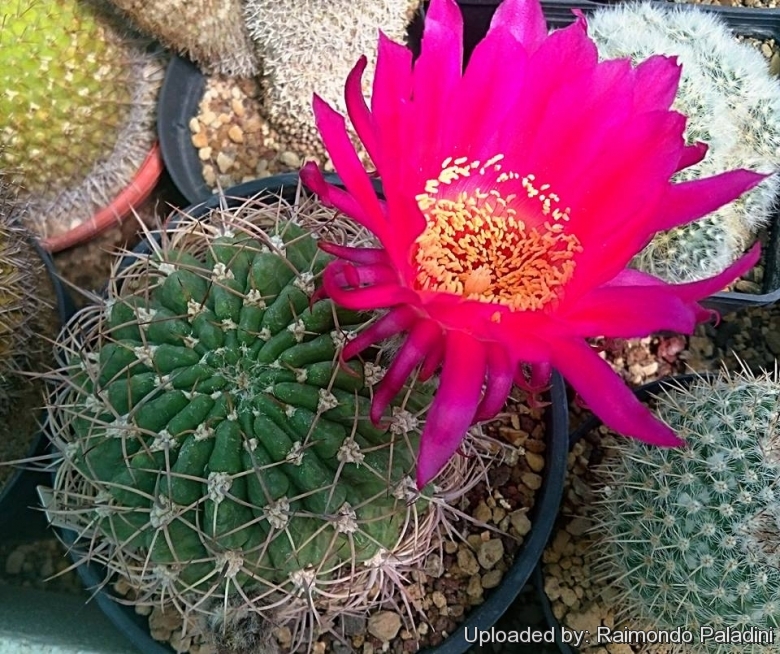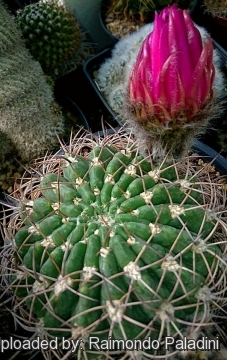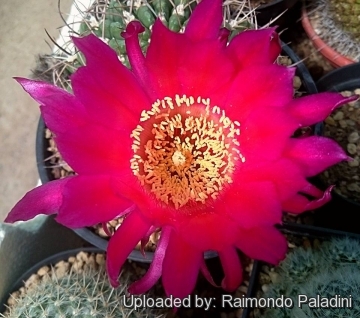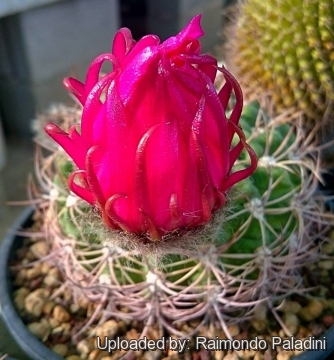Donate now to support the LLIFLE projects.
Your support is critical to our success.
Your support is critical to our success.
= Echinopsis formosa subs. kieslingii (Rausch) M.Lowry
Cactaceae Syst. Init. 14: 13. 2002 [Oct 2002]
Accepted Scientific Name: Echinopsis formosa (Pfeiff.) Jacobi ex Salm-Dyck
Cact. Hort. Dyck. (1849) 39. 1850 [1-6 Apr 1850]

Lobivia kieslingii (Echinopsis formosa subs. kieslingii) Photo by: Raimondo Paladini
Lobivia (Soehrensia) Kieslingii WR573, Santa Maria, Tucuman, Argentina.
Lobivia (Soehrensia) Kieslingii WR573, Santa Maria, Tucuman, Argentina.
Synonyms:
- Echinopsis formosa subs. kieslingii (Rausch) M.Lowry
- Echinopsis kieslingii (Rausch) Anceschi & Magli
- Lobivia kieslingii Rausch
See all synonyms of Echinopsis formosa
back
Accepted name in llifle Database:Echinopsis formosa (Pfeiff.) Jacobi ex Salm-Dyck
Cact. Hort. Dyck. (1849) 39. 1850 [1-6 Apr 1850]
Synonymy: 29
- Echinopsis formosa (Pfeiff.) Jacobi ex Salm-Dyck
- Acanthocalycium formosum (hort. ex Pfeiff.) Backeb.
- Cereus gilliesii F.A.C.Weber in Bois
- Echinocactus formosus Pfeiff.
- Echinonyctanthus formosus Lawr.
- Lobivia formosa (Pfeiff.) Dodds
- Soehrensia formosa (Pfeiff.) Backeb.
- Trichocereus formosus (Pfeiff.) F.Ritter
- Echinopsis formosa subs. kieslingii (Rausch) M.Lowry
- Echinopsis kieslingii (Rausch) Anceschi & Magli
- Lobivia kieslingii Rausch
- Echinopsis formosa var. maxima (Backeb.)
- Soehrensia formosa var. maxima Backeb.
- Echinopsis formosa var. pinchasensis (Rausch)
- Echinopsis formosa var. polycephala (Backeb.)
- Echinopsis formosa subs. rosarioana (Rausch) M.Lowry
- Lobivia formosa var. rosarioana (Rausch) Rausch
- Lobivia rosarioana Rausch
- Echinopsis oreopogon (Speg.) Werderm.
- Acanthocalycium oreopogon (Werderm. ex Speg.) Backeb. in Backeb. & F.M.Knuth
- Lobivia oreopepon Speg.
- Lobivia oreopogon Werderm. in Backeb. & Werderm.
- Soehrensia oreopepon (Speg.) Backeb.
- Echinopsis uebelmanniana (Lembcke & Backeb.) A.E.Hoffm.
- Lobivia formosa var. uebelmanniana (Lembcke & Backeb.) Rausch
- Soehrensia uebelmanniana Lembcke & Lembcke
- Trichocereus uebelmannianus (Lembcke & Lembcke) F.Ritter
Echinopsis formosa var. albispina F.A.C.Weber ex Schelle
Handb. Kakteenkult. 118 118 1907
Synonymy: 2
- Echinopsis formosa var. albispina F.A.C.Weber ex Schelle
- Acanthocalycium formosanum var. albispinum (F.A.C.Weber ex Schelle) Y.Itô
Echinopsis formosa subs. korethroides (Werderm.) M.Lowry
Cactaceae Syst. Init. 14: 13. 2002 [Oct 2002]
Synonymy: 6
- Echinopsis formosa subs. korethroides (Werderm.) M.Lowry
- Echinopsis korethroides Werderm.
- Eriosyce korethroides (Werderm.) Backeb. in Backeb. & F.M.Knuth
- Lobivia korethroides (Werderm.) Werderm.
- Soehrensia korethroides (Werderm.) Backeb.
- Trichocereus korethroides (Werderm.) H.P.Kelsey & Dayton
Echinopsis formosa subs. randallii (Cárdenas) M.Lowry
Cactaceae Syst. Init. 14: 13. 2002 [Oct 2002]
Synonymy: 5
- Echinopsis formosa subs. randallii (Cárdenas) M.Lowry
- Echinopsis randallii (Cárdenas) H.Friedrich & G.D.Rowley
- Helianthocereus randallii (Cárdenas) Backeb.
- Lobivia formosa var. randallii (Cárdenas) Rausch
- Trichocereus randallii Cárdenas
back

Lobivia kieslingii (Echinopsis formosa subs. kieslingii) Photo by: Raimondo Paladini

Lobivia kieslingii (Echinopsis formosa subs. kieslingii) Photo by: Raimondo Paladini

Lobivia kieslingii (Echinopsis formosa subs. kieslingii) Photo by: Raimondo Paladini
Send a photo of this plant.
The gallery now contains thousands of pictures, however it is possible to do even more. We are, of course, seeking photos of species not yet shown in the gallery but not only that, we are also looking for better pictures than those already present. Read More...
The gallery now contains thousands of pictures, however it is possible to do even more. We are, of course, seeking photos of species not yet shown in the gallery but not only that, we are also looking for better pictures than those already present. Read More...
| Your Actions | |
|---|---|
| Back to Lobivia index | |
| Back to Cactaceae index | |
 |
Back to Cacti Encyclopedia index |








